The industry is flourishing in France with the growth of solar and other energy markets, innovations in research and development, and promotion of optics and photonics across the nation. These and numerous other initiatives are priming France to become an even more significant player.
Talk of climate change, global warming, ozone-layer depletion and rising air pollution has many working to reduce their carbon footprint — France included. The country’s many initiatives in the optics and photonics sectors include a number of sustainable development projects now underway (with more in the pipeline), as the country makes a push toward becoming more energy-efficient. Anticipated growth of the solar, photovoltaic (PV) and energy markets worldwide and across Europe could bolster these efforts.
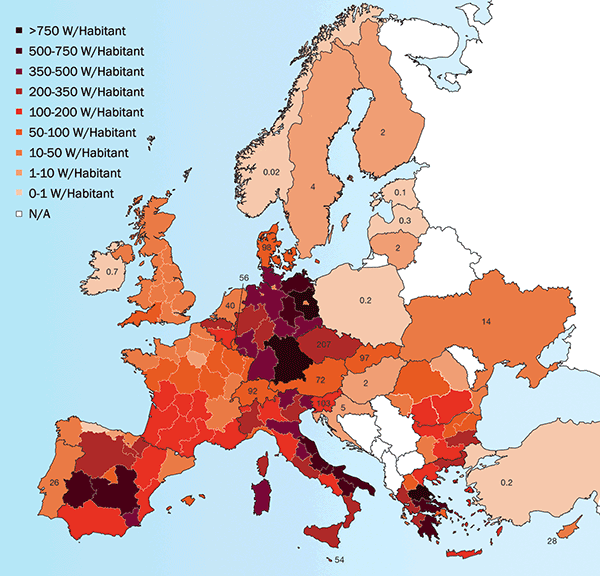
European PV installations per habitant. Courtesy of SolarPower Europe.
“Solar photovoltaics is on the way to becoming a major part of the electricity system, delivering clean, safe and affordable energy to the greater number all around the globe,” said Oliver Schäfer, president of the European Photovoltaic Industry Association (EPIA).
Globally, the PV market is expected to grow to nearly $350 billion by 2020, according to a report by ReportsnReports, with Europe holding almost 24 percent of the major market share. But while several European nations do already have well-developed PV markets, France has seen a dip following a surge in 2011-2012.
However, the EPIA report now sees France as possessing untapped potential for increasing its PV installation and energy capacity. The report’s findings cite political decisions by the French government to reduce incentives and funding for PV installation as the cause of decline in recent years, and the administration has since agreed to allow 1 GW of new capacity to be installed annually. A new law was enacted earlier this year; such moves should help turn things around, according to EPIA.
The law, approved by the French parliament in March, requires that the tops of all new buildings in commercial zones across the nation be at least partially covered by plants. According to ThinkProgress.org, a blog and project under the Center for American Progress Action Fund (a nonpartisan policy institute and advocacy organization), such “green roofs” are rooftops covered by “a layer of grasses, shrubs, flowers and other forms of flora.” Under the law, building owners also have the option of covering the roof surface with solar panels instead.
Other such initiatives across France include work done earlier this year to make the more than 125-year-old Eiffel Tower more energy-efficient, while maintaining its look and history. Société d’Exploitation de la Tour Eiffel (SETE, the company that operates the Eiffel Tower) partnered with New York City-based Urban Green Energy (UGE) International Ltd. on a project that has equipped the historic structure with LED lighting, solar panels and wind turbines. This work is part of a renovation and upgrade project within the City of Paris Climate Plan, led by Mayor Anne Hidalgo.
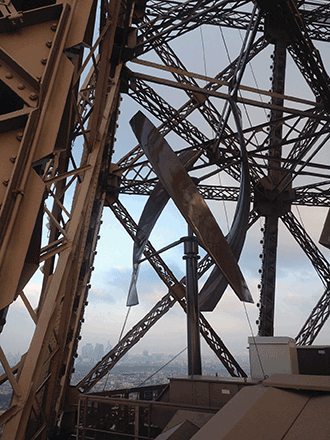
Part of a clean-source energy system designed by UGE International, LED lighting and roof-mounted solar panels are sharing space with two vertical-axis wind turbines that have been installed on the Eiffel Tower. Courtesy of UGE International.
Join the group
France is poised for further growth, in line with other European nations. According to a report by CNOP (the French National Committee for Optics and Photonics), industrial production in optics and photonics in France features 1000 companies, 50,000 direct jobs and 150,000 indirect jobs. Overall, the European photonics industry’s production of optics and photonics components generates more than €40 billion (about $44.8 billion) in annual revenues; it also accounts for nearly 20 percent of the world market, employing 245,000 people.
The industry spotlight is shining brighter and brighter in France, too, with such projects as Challenge Photonics. Proposed by AFOP (the French Association of Optics and Photonics), sponsored by Sagem and Thales Group, and managed by CNOP, it reinforces “competiveness in small- and medium-sized industries in strategic industrial fields and sectors,” according to CNOP. The project serves to “revitalize in a sustainable way and maintain on the national territory the activities linked to the photonics sector.” Telecommunications, lighting and displays, manufacturing, and security in particular are among areas seeing growth.
CNOP brings together “key French players in optics-photonics,” including the French government and companies and organizations throughout Europe. AFOP operates in a similar way — it plays an active role in “the implementation of technical actions, markets and statistics, administrative and management, communication, and training and employment.” The French Optical Society (SFO) is another such organization; it brings together all areas of optics, engineers, researchers, teachers and others.
Among those involved with these groups is Opticsvalley, a Paris-based support network. It promotes innovation and development among optics- and photonics-related companies, laboratories, higher education centers, subject matter experts and others. The network is supported by local and regional governments, and essentially brings together companies, research and training centers, and institutional partners to support the advancement of optics and photonics.
Opticsvalley also promotes the industry as a member of the Photonics4All project. The European Commission-funded Horizon 2020 European Outreach program works to educate the public — namely young people, early career researchers and entrepreneurs — about the industry.
Through collaboration amongst many European players, Photonics4All’s mission is ultimately “to generate a more qualified workforce and young academics, more innovative applications, and an increased awareness of photonics.”
Research and development
Augustin-Jean Fresnel, a 19th century French physicist, is well-known for his work in the optics and photonics industry. His research added to the establishment of the wave theory of light and polarization; that is, light is a wave, not a stream of corpuscles or particles, as was previously believed.

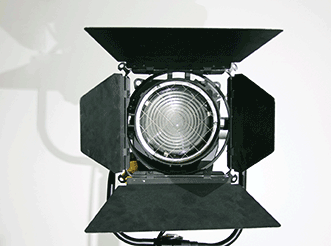
The Fresnel lens, created by Augustin-Jean Fresnel in the early 1800s, was originally developed for use in lighthouses.
Fresnel’s development of the lens (and many variations of it) that bears his name made him a pioneer in the industry. The lens, originally developed for use in lighthouses, remains popular for many products, such as imaging cameras, solar cells and light sources, as well as for applications in biophotonics, defense and security. Lighthouses also still use these lenses today. Fresnel’s discoveries, theories and equations have had a major influence on modern light-based and optical innovations, from computers and mobile phones to imaging and optical devices.
Fresnel and others led the way for today’s optics and photonics researchers, particularly in France, where technological innovation is flourishing. Several years ago, under then-president Nicolas Sarkozy, there was a push to make R&D a national priority, and France was cited as a growing European “powerhouse” in R&D (Photonics Spectra, February 2009).
Notable work in the years since that initial push includes the development of a new laser biospeckle technique by researchers at the University of Western Brittany in Brest, in collaboration with Saint Joseph University in Lebanon (Photonics Spectra, February 2015).
The technique allows the noninvasive detection of the peak of ripeness of climacteric fruits — apples, bananas, pears, melons and tomatoes, among others. The researchers used a laser beam, polarizers and quarter-wave plates to generate different incident polarizations. Also, they used CMOS and CCD cameras to record the speckle pattern created when photons scattered by a medium interfere with the incident light field. Agriculturalists are expected to benefit the most from the new laser technique, according to the researchers. Rana Nassif, a postdoctoral researcher affiliated with both universities, noted that “most tests used today are either destructive or based on visual criteria that are often wrong.”
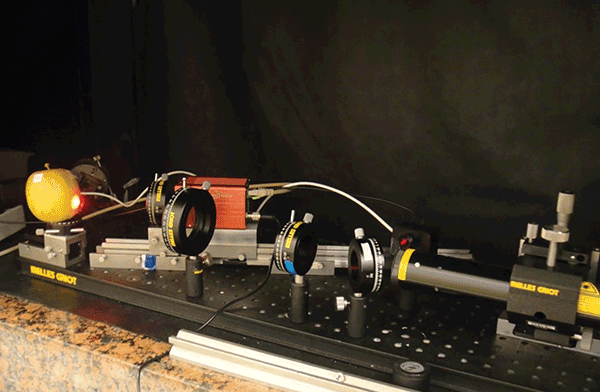
A laser beam, polarizers and quarter-wave plates produce a speckle pattern on an apple. Courtesy of Rana Nassif.
Imaging techniques and technologies are maturing worldwide, according to Dr. Albert Theuwissen, founder of Harvest Imaging in Grenoble, France.
“Processing power is getting cheaper by the days, and the same is true for memories. So the processing after an image sensor will still grow, imaging systems will become higher performance, lower power and will become commodities,” he said. “Imagers will be found in every corner of every room, on every corner of every street.”
Organizations like the Centre National de la Recherche Scientifique (CNRS) are steadfast in their efforts to further advance optics and photonics research in France. A public organization under the French Ministry of Education and Research, CNRS comprises numerous institutes covering various aspects of the industry — from biological sciences, the environment and physics, to astronomy and engineering.
CNRS works with groups including the European Research and International Cooperation Department, which promotes and supports CNRS’ international initiatives that are “an essential tool to enhance French research attractiveness and visibility abroad.”
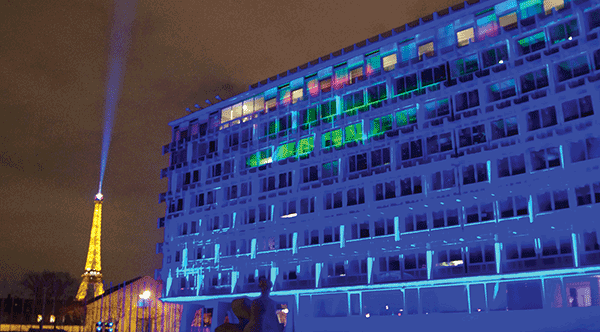
The UNESCO building lit up the Paris sky in January during the opening ceremony for the International Year of Light and Light-Based Technologies (IYL2015). Courtesy of SPIE.
International Year of Light
Paris hosted the opening ceremonies for the International Year of Light and Light-Based Technologies (IYL2015) in January, aiming to raise awareness of how photonics and optics promote sustainable development, and provide solutions to worldwide challenges in energy, education, agriculture, communications and health.
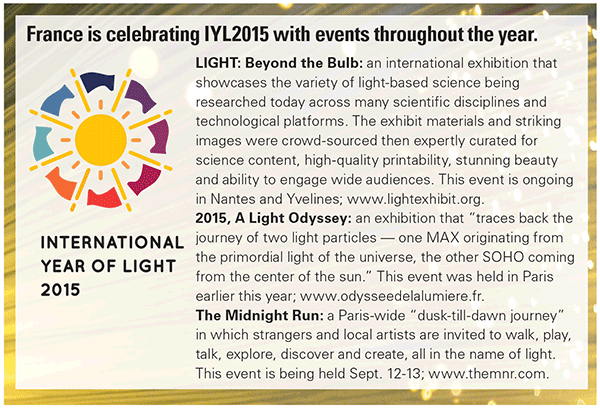
Industry experts were among those who attended the opening event, including Claude Cohen-Tannoudji — whose work with laser cooling of atoms garnered him the Nobel Prize in physics in 1997.
More innovation to come
From the pioneering work of Fresnel to today’s highly advancing technology, France is flourishing — from knowing when a fruit has hit peak ripeness without even touching it, to the development of a new terahertz system that can transmit data at an advanced rate of 32 Gb/s over 25 m, and a new medical imaging system that once filled an entire lab bench but can now fit in a doctor’s hand.
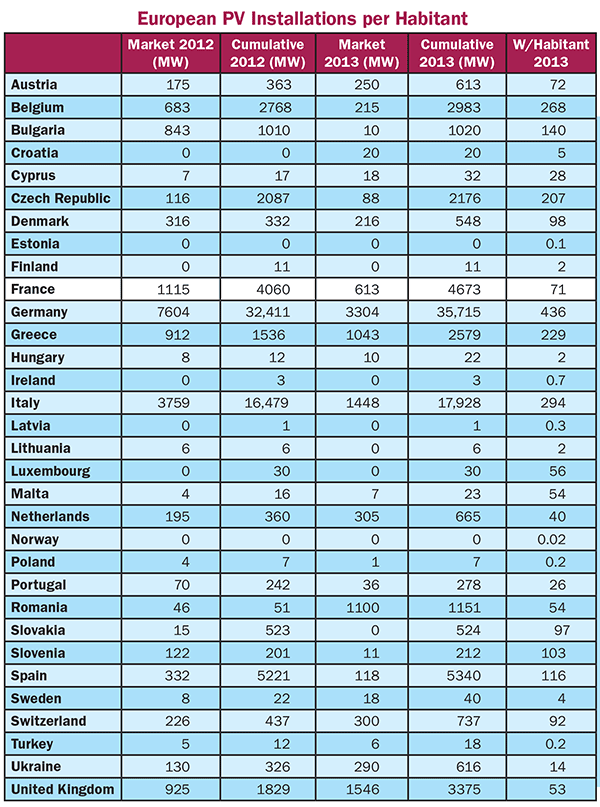
The nation’s solar and PV realms are poised to grow significantly in the next several years. Behind the carbon-footprint-reducing natural energy initiatives now in place at the Eiffel Tower, other such landmarks and regions are sure to follow suit.
While the future is yet to be seen, many recognize great industry potential in this European nation. One thing is for sure: in the optics and photonics industry, France is a top contender.